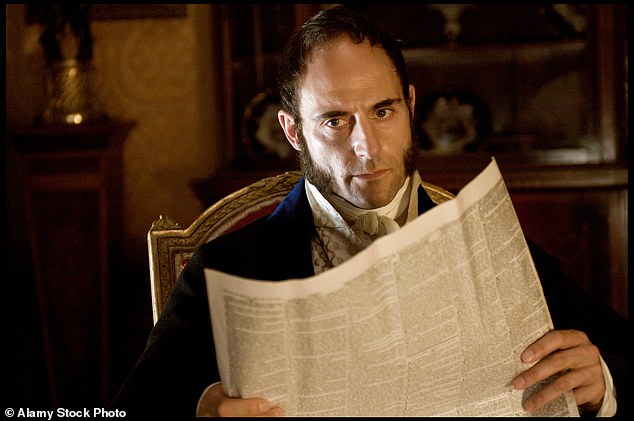That bitter Wills v Harry fallout? It must run in the family! Queen Victoria fought a MOTHER FROM HELL (who imprisoned her daughter in Kensington and tried to seize the crown herself…)

The ongoing hostilities between brothers William and Harry are by no means the first close family row to blight the Royal Family.
For if Queen Victoria was angry with her eldest son, Bertie – the future Edward VII – for his wayward philandering, this was as nothing to the fury reserved for her own mother, the Duchess of Kent.
The widow of the late Prince Edward, Duke of Kent, fourth son of George III, German-born Princess Victoria of Saxe-Coburg-Saalfeld truly became a Mum from Hell, controlling the every waking moment of her daughter in an attempt to stifle the slightest sign of independence.

Sir John Conroy, Victoria, the Duchess of Kent and the Young Victoria as played by Mark Strong, Miranda Richardson and Emily Blunt in the film The Young Victoria

Victoria at age two, with her mother, the duchess of Kent in a portrait dated 1821

Sir John Conroy, played here by Mark Strong, wanted to bring about a Regency which would mean that he and the Duchess of Kent would control the country, not Victoria
As is widely acknowledged by historians, the Duchess and her close associate John Conroy, were determined to bring about a Regency following the eventual death of King William IV, which meant that they, and not her daughter Victoria, would control the country.
Author Tom Quinn writes that King William IV had rightly guessed that his sister-in-law, the duchess, hoped he would die before Victoria reached the age of 18 and that the duchess intended to rule herself.
‘Even more worrying was the fact that it was generally believe that … the real power would lie with her adviser, the Irish aristocrat Sir John Conroy, a man who ruled the duchess as she ruled Victoria.
‘Personal animosity resulted in the Duchess of Kent making every effort to keep Victoria as far away from her uncle William as possible.’
Indeed, Victoria was kept away from almost everyone and everything, a near prisoner at Kensington Palace, without friends, and with every minute of her life monitored by her mother and Conroy, who served as Comptroller of the Kent household at the palace.
Known as the ‘Kensington System’, the regime was designed to keep Victoria dependent upon her mother and free from the influence of her ‘wicked’ uncles, George IV and his brother William IV with their well-documented womanising.
Eventually, an invitation to dine at Windsor arrived that could not be avoided, explains Quinn: a lavish affair to celebrate the birthday of Queen Adelaide, wife of William IV.

William IV, Victoria’s uncle, was one of the so-called ‘Wicked Uncles’ – the sons of George III. Along with the Prince Regent, later George IV, William was headstrong, selfish and addicted to vast indulgence

Victoria, played by Emily Blunt, became Queen just weeks after turning 18 with the death of her uncle, William IV. And so a Regency was averted

Miranda Richardson as Queen Victoria’s mother, Victoria, the German-born Duchess of Kent. One of the young Queen’s first acts on her accession was to move her bed out of her mother’s bedroom
‘The dinner allowed William to make a direct, scathing and very public attack on the duchess,’ explains Quinn in his book Scandals of the Royal Palaces – An Intimate Memoir of Royals Behaving Badly.
‘In a speech listened to in stunned silence, he complained that she had helped herself to parts of Kensington Palace without permission and that his one remaining aim in life was to live another year to thwart the ambition of the ‘incompetent duchess’ and her ‘evil advisers’.
William, as it turned out, lived just long enough to ensure that his niece Victoria became Queen. He died on June 20, 1837; Victoria had turned 18 just a few weeks before.
One of her first acts on her accession was to move her bed out of her mother’s bedroom. She banished Conroy from the premises in perpetuity.
- Scandals of the Royal Palaces – An Intimate Memoir of Royals Behaving Badly by Tom Quinn is published by Biteback, price £20




